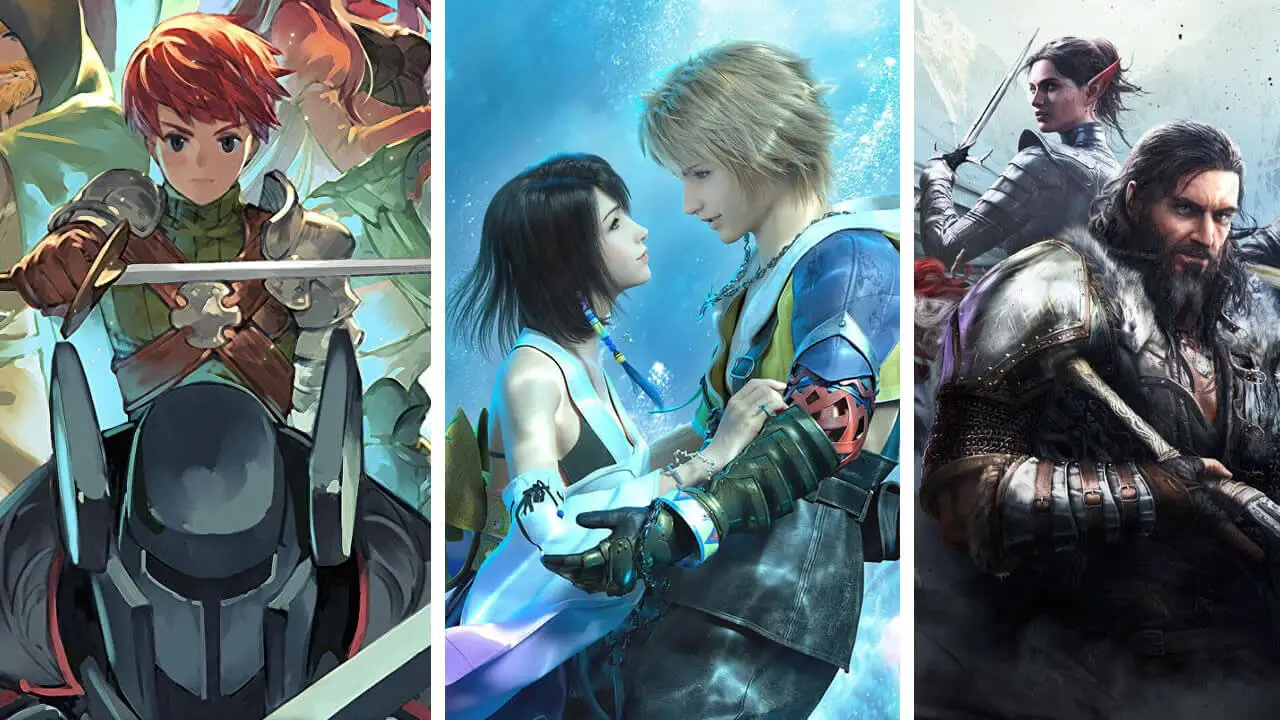Hello readers! I am just a common raccoon that you may find looting your bin. When I am not enjoying this kind of trashy activity, I play turn-based games and give my opinion about them, especially to anyone not interested in hearing it. It appears that today, this “anyone” is YOU!
And I want to talk to you about a heart-breaking opposition between our Beloved Turn-Based games and the Sacrosanct Pace of Play. This speech of mine will, of course, be biased. You have been warned.
Ever talked to one of your slightly gamer friends about this fantastic turn-based game you just discovered and why he should definitely dig into it? If you have the same friends I do, the answer you had was probably along lines such as “Oh, turn-based? Not interested…” or “It looks boring…” or even better: “It’s not an AAA action-rpg game, I only play those!”.
Usually, you’re there wondering how it has come to this. A few years… No… I’m not that young! A pair of decades earlier, turn-based games didn’t scare gamers. For sure, there weren’t as many gamers. But still, turn-based games were battling on par with platformers and shooters.
But there is hope my friends! As some of you have noticed, for a few years now, turn-based games are a force to be considered again in video games!
So, today, I will give an answer (maybe not the best one) to this question:
How did turn-based games start this revival, and will it keep going?
I wanna play, NOW!
To answer this question, we have to return to our friend who found our beloved turn-based game slow and boring. What was it that made it look that way? Let’s put ourselves in his shoes and try to look at it from his perspective. For the sake of example, let’s say this conversation with your friend took place around… 2007… Toooootallly randomly… Not at all chosen to ease making my point.
So we are now your friend. Victim of your endless harassment, we eventually started this game we borrowed. And, well, for the first hour, we didn’t play that much… Most of the time, turn-based games use a lot of narration, and when you played within that first hour, it consisted mostly in pressing the button the game told you to press, resulting in an unimpressive action.

You’re right Wakka! I really hope the game will take me by the hand for two full minutes to make me cast a spell to overcome this monstrosity!
The game needs to do that, of course! Since it has to teach you its specific mechanics. But still… You are bound to learn the game for quite some time, even several hours in most cases. But hey, you can just skip all that and get to the actual playing, right?
Poor soul. You just fell into the trap that killed most aspiring turn-based game players. You are now deep in the game’s mechanics without understanding it at all and are bound to learn in one of three ways if you wish to continue:
- The strenuous way: Starting over and actually reading what the game says… It already felt long with just rushing it…
- The painful way: dying. Over and over again. Until you figure something out or kill your controller from the frustration.
- The unacceptable way: asking your friends for advice. He would be way too happy and annoying teaching you how to do it…
If you actually read what was displayed (or learned through one of the three methods), you find yourself with everything you need to play this game. Yay!!! And if we are indeed around 2010, chances are you are playing something Final Fantasy -esque or a tactical RPG. And you find yourself using that thing a lot. Yeah, that thing. The “Attack” command. Not like you have much choice anyway. Or not for long, seeing how that depletes your mana. And gosh! That is repetitive! If you were playing one of your usual action RPGs, you would have to press one button to do that, or even better, press it again to combo!
And this example is rooted quite deeply in turn-based games. If you look at the SNES era, or even a bit later with Playstation 1, or later again with Playstation 2, it was the most common thing to do in turn-based games. And what’s more, for selecting the Attack command, you were almost always rewarded with an uninteresting animation that lasted longer and longer over the years.
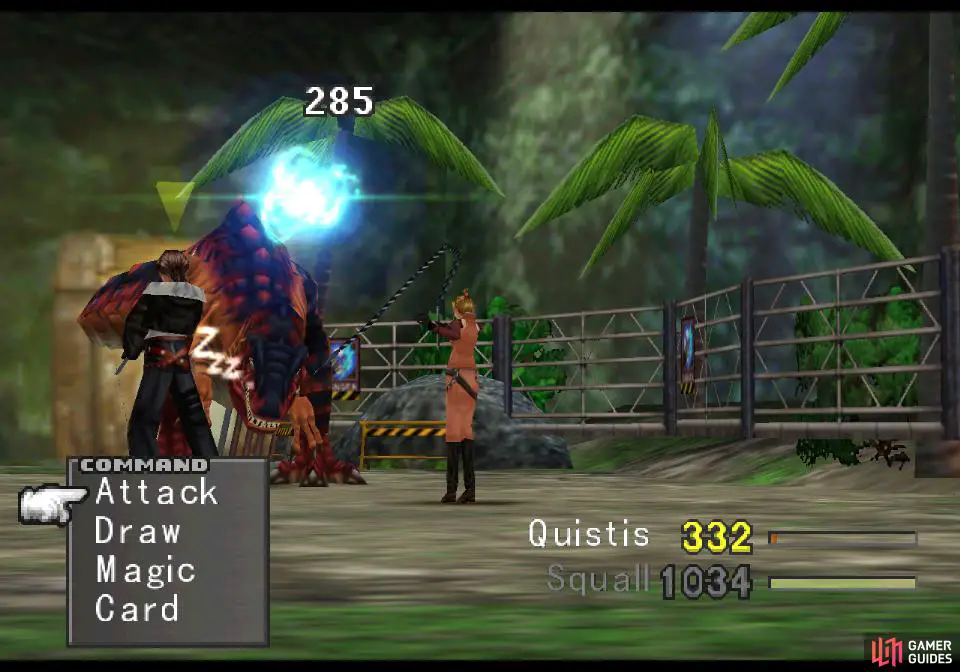
I’m pretty sure this “Attack” is gonna be epic and fast!
Now if you could live through this monotony of the Attack command, it’s not like you could do it all the time. Quite obviously, a “turn-based” game means everyone has to play their turn! Including the enemy! Some games made it quick. Some did not bother. And some had loads and loads of enemies! And yes, you had to wait for every one of them to play their turn, one at a time, while you watched. It is only logical: you need the information about what your foes are doing. But still, assuming enemies are as numerous as you, you spend half your time in battles to watch them act while doing nothing, if screaming in despair when they ripped your team apart in the most dreadful cases.
That should be all the downsides you can find to playing a turn-based game, right? Well yes. For the time, you are “playing” it at least. You fool! You can’t go into battle without preparation! You must spend at least as much time on the menus to prepare yourself! Leave aside all that you must learn to understand what you’re doing! You really thought it was that easy?

All these blue-circled enemies will play their turn quickly… Right?
Ok, enough about this. Let’s get some action. As we said to begin with, we want to play video games!
I’m bored, let’s get some action!
Ok, enough freaky-fridaying. Let’s get back into our very own self of Turn-Based Lovers™.
We have heard these flaws of our beloved games way too many times. And they are not incorrect at all. But back then, it didn’t matter. I may be talking about a time the young ones don’t remember (What do you mean people born after 2000 can be adults now??), but these flaws have always been there. So what made turn-based games so great and popular back then? This can be answered easily: the lack of competition.
Let’s make a simple drill together. Think fast.
Give three turn-based games from PS2/Gamecube/Xbox.
Hard to choose, right?
Give three turn-based games from PS3/Wii/Xbox 360.
Hard to find, isn’t it?
Technical improvement with this generation allowed action games to be smoother and prettier and to include more features. Add to this a few studios trying some new stuff, and suddenly, real-time games include some features that used to be the privilege of turn-based games without the issue with the pace of play. Also, most of the flaws of action games (hello camera angles!) improved considerably (although big improvements were also witnessed at the previous generation change).
At the same time, more and more people were playing games at that time: kids became adults that played games, and new kids were also playing games! Bring into that context some game-changing (pun intended) names like Skyrim, Fallout, Bioshock, Mass Effect or Dark Souls, and you’ll see turn-based games become a niche genre.
I think that’s how you get more than a decade dominated by “real-time” games. And every publisher would come on scene at every big video game event, and every time they would say the exact same sentence about their upcoming game “Open world action RPG”.
Now I want it all!
Have things changed? Well not really, but they are changing! As I told you, there is hope! Two things happened during that span: action-RPG kind of repeated themselves A LOT to the point where each new game felt the same in a different context. And at the same time, turn-based games tried really hard to overcome their main flow of the past: pace of play!
Because yes, my dear readers, I WILL tell you about turn-based games in this column! Because that is what we do!
So, how did turn-based games metamorphose themselves to be more dynamic? Several strategies came up.
Just make it faster!
Do you want the game to feel faster? Let’s make it faster! Less health, more damage! Simple right? Games such as Darkest Dungeon exploited this to the extreme, where a single blow could be devastating for your team. Indie games also opted for this solution multiple times, in games such as Cosmic Star Heroine, where basic attack command is not a thing. More recently Chained Echoes also went for faster battles, and while it kept the boring attack command, it also made it into a last resort you won’t use often. This big damage / low hp solution is actually nothing new (I already hear people yelling Chrono Trigger in the back…). But it became a necessity rather than a design choice.
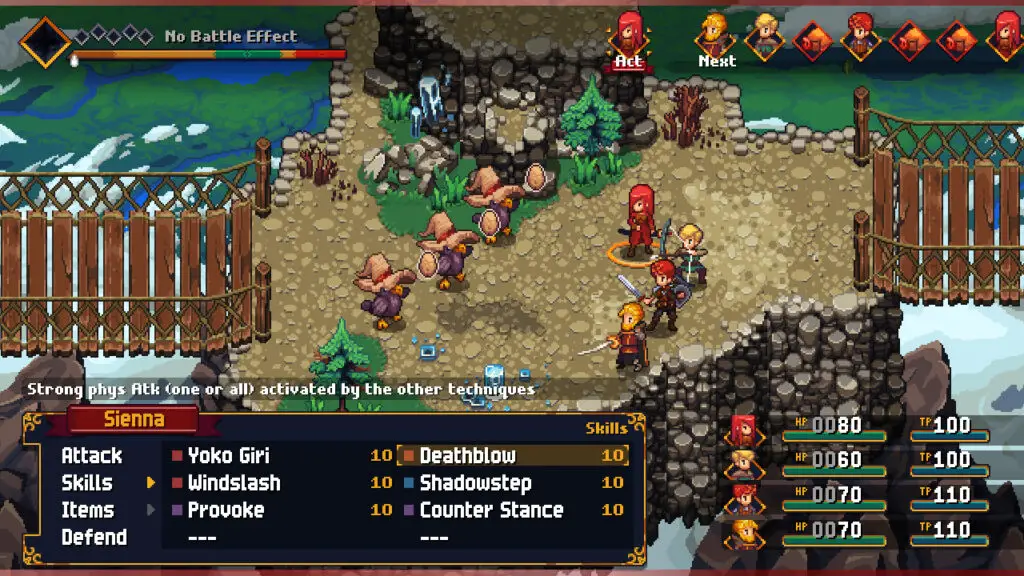
Basic Attack command has never been so obsolete and reserved to dire times than in Chained Echoes
Make it dynamic, more play-time!
Getting rid of waiting times was also a way, and the most notable one in my opinion. If, like me, you tried to initiate a lost lamb to turn-based Greatness, you may have done so using a masterpiece at reducing waiting times: Persona 5. This Shin Megami Tensei entry succeeded where seemingly none other did before and by doing the most straightforward thing: optimizing UI. No more pressing five buttons and scrolling through twelve lines to use the most basic spell. No more boring menu with basic frames and colors.
Welcome smooth transitions and smart key binding. It did so well that Yakuza almost immediately copied it to create the first turn-based RPG of the franchise. Now, try to convince me that turn-based is not the future because of its slowness when a beat ’em-up franchise switches to turn-based mechanics! Like it or not, Persona 5 has opened the door to the renewed popularity of turn-based RPG, and without compromising what its ancestors made. Unlike others. Yes, I AM looking at you, remake of the most beloved RPG.
Appealing to a much less broad audience, Octopath Traveler also played the dynamic card. It’s not like it is fast or has smooth transitions. Quite the opposite. But battles have this deeply strategic side, where you try your best to make your biggest burst of damage come when your foes are weakened. The expendable nature of turns and the loss of turns of the enemies make it for more playtime.
Another way to make gameplay more dynamic, directly inherited from tabletop RPGs, is to bring a lot of contextual action in battles. Of course, I’m talking CRPG here, and how not to talk about Divinity: Original Sin 2. The dynamic field of battles, being set on fire, extinguished, then frozen before getting thawed and electrocuted blows away any repetitiveness in battles. Unless you are breaking the game with telekinesis…
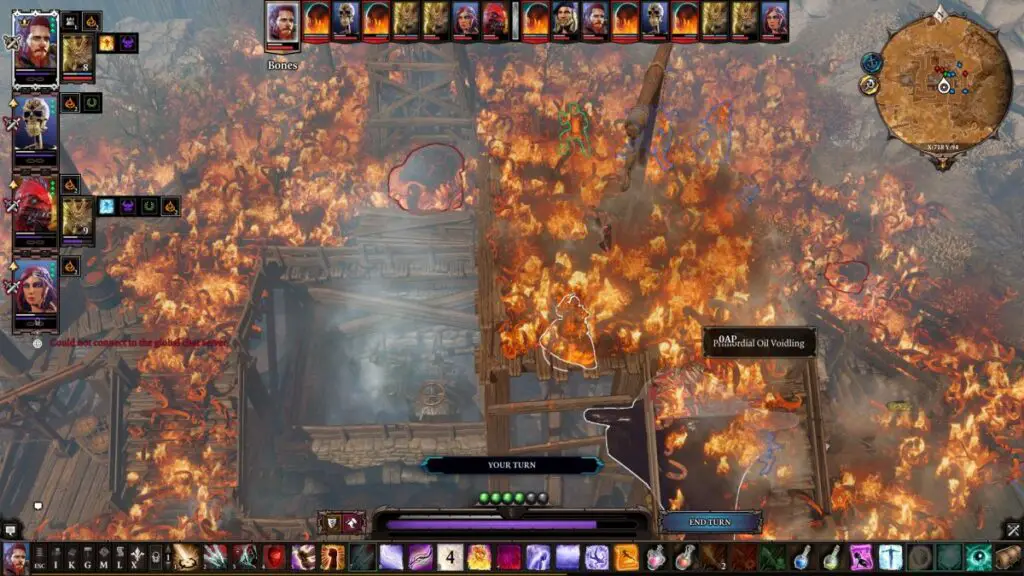
What do you mean by “Mind your steps”?
Turn-based doesn’t mean I have to wait for NPC’s turn!
We stated the annoyance of having half the time in battles consisting in watching the enemy play, thus reducing actual playtime. How could we get rid of that? One word: asymmetry. Most turn-based gameplays are unbalanced (in favor of the player if you’re not Darkest Dungeon), but they are still symmetrical. You play an action. One enemy plays an action. Repeat. By breaking this symmetry, one could reduce this waiting time.
It’s nothing new but it has been growing lately and pushed a bit further. The Last Spell is one brilliant example of how asymmetric gameplay drastically increases the player’s active time. The game is not faster, more dynamic, or has fewer menus than old-school tactical RPG. But the sole fact that the enemies play all at once in a minute, while you have all the time in the world to plan and act for your characters once it is your turn blows away any sensation of slowness. If anything, you feel like THEY are coming way too fast at you!
Let’s do something else in between.
Not my favorite card in the mix, but diversification of gameplay is also a way to appeal to more players. Here, we are mostly thinking about exploration, which is often sharing the playtime with battles in turn-based RPGs. Older games made it (too?) simple: explore corners of the map, find secrets, and be happy. Later games are trying things differently. We talked earlier about Octopath Traveler battles, we have to talk about its exploration, where using the capacities of your eight heroes is a refreshing aspect of the game. But it stayed very classic. On the bolder side, we can find Monster Sanctuary, which, by making all its exploration a 2D metroidvania platformer, brought a big chunk of different gameplay. This exploration using your monster’s abilities made a point of having as many different monsters as possible more interesting. These games also featured polished turn-based battles, but they succeeded in doing more than that.
Why change anything? We are already perfect!
Some others did not try to change anything about the dynamic of their battles. Let’s talk about Monster Sanctuary again, because it deserves to be praised. This indie gem just took the good old Pokemon-esque battles and made them way more strategic. None of its mechanics is new, but its arrangement makes it attain greatness. Apart from classical weaknesses and resistances, it featured some deep-building options for each and every one of its monsters and gave all the keys to the player to find a way to win each battle. It is genuinely classical but great.
On a much bigger scale, Dragon Quest XI is an example of a classical turn-based RPG. There is barely anything original in there. But, somehow, the alchemy is there, and it just feels wonderful to play the true heir of its legacy.
Tactical RPGs are also well-represented lately. The Fire Emblem franchise has kept fans since the early GameBoy era and is doing well. Triangle Strategy, one of the few recent successes of Square Enix, also brought some good vibes while keeping it classic. So maybe nothing needs to be changed after all…
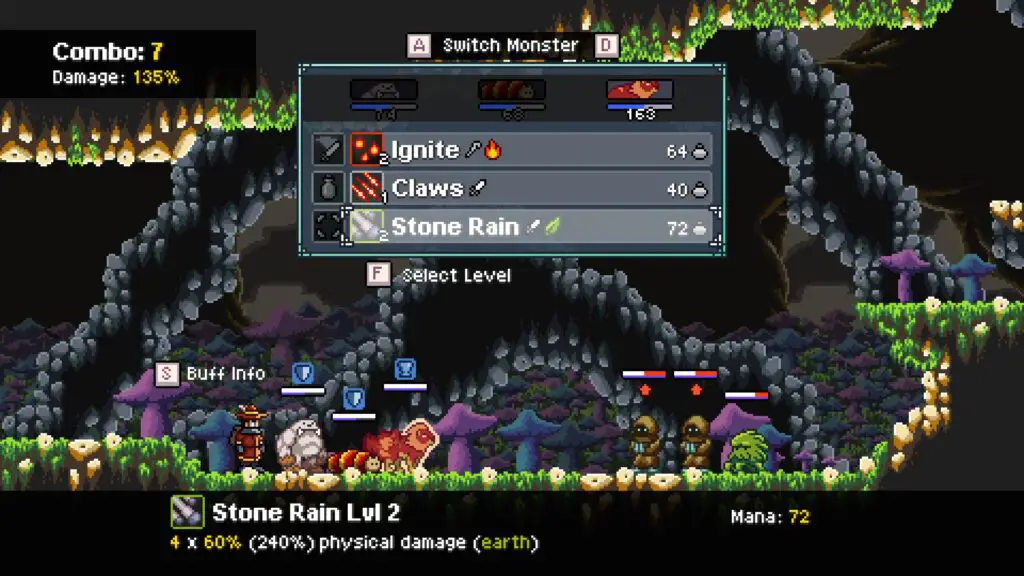
Monster Sanctuary, or how to use classic mechanics to make something new
Is the future… The past?
So how did they do it? How did turn-based games become appealing again? Well, as you can see, in a variety of ways! And that’s what is so great about it and about games in general. Where seemingly every recent action RPG tends to look like The Witcher or Zelda: Breath of the Wild, recent turn-based RPGs look very diverse. Approaches to be different from the others are multiple, and each one gives a refreshing feeling of novelty. Even games that did not innovate in any way get this refreshing taste, as they benefited from the diversification of the turn-based games environment: If you don’t change, but everyone who used to look like you changed, you suddenly become different from others as well.
So, my friends. Rejoice! Turn-based is the future! And we can delight ourselves already from what’s to come.
But be warned, history may repeat itself. And if turn-based games win one great battle, it may become all the same again… And it might already be happening before our very eyes. Yakuza: Like a Dragon, while bringing tons of fun, may be the premise of a new era of uniformed turn-based games. The incredible performance of Persona 5 has already inspired others.
Octopath Traveler already has an agreeable but unoriginal sequel. Big studios keep reviving old hits such as Tactics Ogre. And some even renounce their legacy by eradicating anything turn-based from their games.
It would be a shame not to play those wonderful games, but we have to keep praising those who think outside the box. To name them, the indie developers. Notably, those whose games I mentioned in this column, but also all the others, as they are, and will keep being, our saviors, banishers of the grim uniformization, and bringers of a bright and diverse turn-based future.
Oh, you are still there? I’m impressed: you are still awake! You probably went to see a lot of movies in Yakuza: Like a Dragon… Well, if you wish to fight soporific sheep again, see you next tim… Sorry! See you next Turn!

